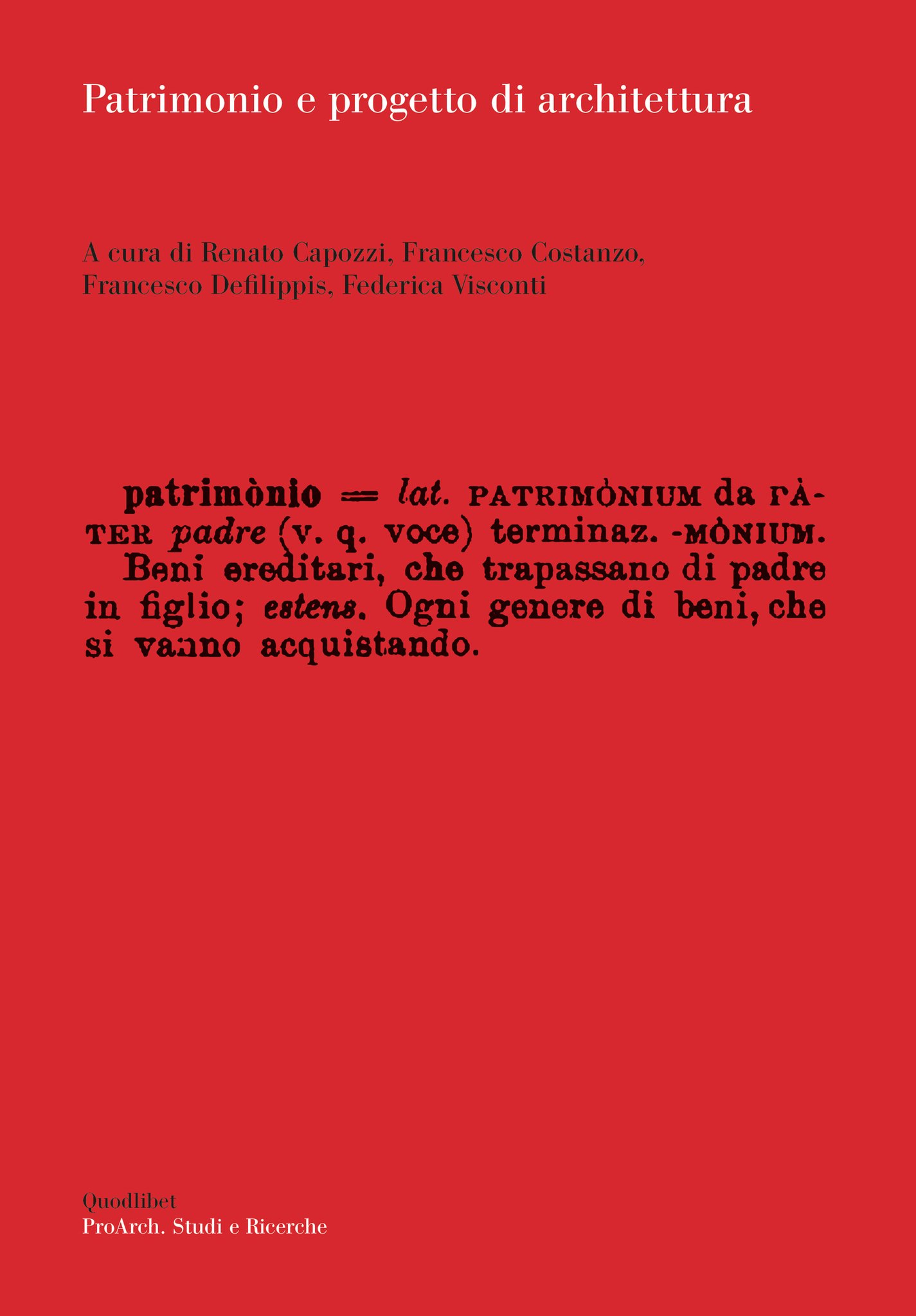Patrimonio e progetto di architettura [Heritage and Architectural Design] is the first issue of the Quodlibet publisher series entitled ProArch. Studi e Ricerche, which focuses on the activities realized by the Italian National Scientific Society of Architectural Design Professors (ProArch).
Together with the title and curators, the entry “Patrimonio / Heritage” from the etymological dictionary is imprinted in Black Courier font at on the 165x240 mm scarlet cover that binds together the series publications, leaving the lower half of the first page to the red field. A mask can hide, or reveal, the distinctive features of what it covers.
The book re-presents an investigation started in 2019, on the occasion of an imposing conference of the scientific society, held at the University Federico II of Naples, on the topic of the relationship between architectural design and heritage, for a renewed notion of the latter through disciplinary intersections. This reflection published two years later, was deepened during the dilated time of Covid-19 pandemic crisis, which occurred shortly after that conference: a global fact recalled by some authors to reinforce their positions about the theme of the world heritage.
The book’s curators deserve the task of finding a difficult synthesis for an heterogeneous mass of contributions through some choices: the selection of the most distinguished voices of the Italian academy; a formal reduction of their thoughts in 5 pages articles; a structure divided into 7 thematic sections – the notion of heritage; heritage and dwelling; heritage and architecture; heritage and city; heritage and archeology; heritage, territory and landscape; heritage policy [eng.trans.] – for a total of 42 articles, preceded by 3 introductory notes and 2 lectures - given by architect José Ignacio Linazasoro and philosopher Silvano Tagliagambe – condensed in 288 pages.
Therefore the volume is – by choice and by necessity – dense, rich, multifarious, partly iterative and notional, sometimes comforting and clear, others provocative and sparkling, and, consequently for those features, fortunately not really doctrinaire or unanimous.
One example above all is the widespread recourse of many authors to the etymological origin of concepts to develop their theses, which at the same time also turn out to be very conflicting, demonstrating the complexity achieved by the topic.
The collected entries come from the entire country offering an updated state-of-the-art about the value and the sense attributed to the heritage and the architecture project by the Italian University, while revealing the conditions in which it moves.
Except for a few discordant exploits, the impression is that of an established or, at least, commonly felt theoretical tradition on the meaning of history and heritage, which, however, in some cases, finds new life from the encounter with the reality of its own time.
So, the book reveals the great task and value of theory, which – like history itself – teaches us nothing directly except by means of its negotiation with reality. This negotiation – surely at least for designers – lies in the project and in its ability to “provoke theory” through its manifestations.
Nevertheless the Project, which is named in the title and repeatedly invoked through the pages like a mantra, along with its outcome, the “Form”, is the great absentee of these pages, the obscure object of a common desire through which verify the authenticity of the theories set forth.
Thus, the empty lower half of the red cover works like a metaphor of an absence, the other side of the mask full of desire, which has no chance to express itself in university research, despite few actual occasion and several appeals to the third mission.
In this critical condition that is reminiscent of the Franciscan expression reinvented by Georg Simmel “omnia habentes, nihil possidentes”, the words of the contribution “La necessità del progetto / The Necessity of the Project” by Bruno Messina, reveal the awareness of the actual state but also a perspective of continuity of research waiting for future opportunities:
«It remains my firm belief that the project, precisely because of its nature as a tool for interpreting and transforming reality, can only be based on the ability to hold together multiple knowledge and multiple techniques around an idea. (...) I am more interested in a theoretical reflection involving a state of advancement of experience, seeking all the operational tools that the project can bring to bear [eng.trans.]».
These words bring to mind the unrivaled concepts expressed by Ernesto Nathan Rogers in his book Esperienza dell’architettura / Experience of Architecture, to which many authors are inspired: the possibility of advancing thought through the study of the great architectural phenomena of the past considered as a collective work and common heritage; the history of architecture as a tool to measure the architectures of our time, so that they may be valid for all times and build a better reality.
Patrimonio e progetto di architettura
Renato Capozzi, Francesco Costanzo, Francesco Defilippis, Federica Visconti
Quodlibet Studio. ProArch. Studi e Ricerche
Macerata
2021
165x240 mm
288 pages
Italian
9788822906809
